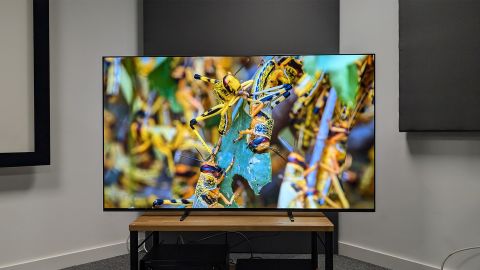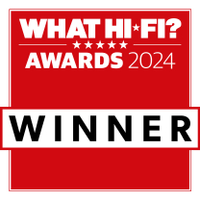The Sony Bravia 8 is one of 2024’s biggest TVs for a couple of reasons. First, because it’s the only new OLED TV from the Japanese home cinema giant to arrive this year. Second, because it is the follow-up to the Sony A80L, which picked up a Product of the Year accolade at the What Hi-Fi? Awards.
Does it live up to its predecessor’s legacy? After putting it through its paces, including side-by-side comparisons with arch-rivals and its predecessor, the answer is a firm yes, but only just.
Price
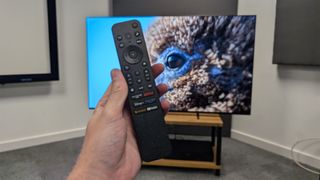
The Bravia 8 is the second most expensive option in Sony’s 2024 range. Some deals have started doing the rounds, but most days you can get the 65-inch model being reviewed here for £2699 / $2800 / AU$4495. The smaller 55-inch Bravia 8 retails for £2199 / $2000 / AU$3495 and the largest 77-inch for £3999 / $3900 / AU$6995.
That puts the Bravia 8 roughly in line with most step-down OLED TVs this year. To put it in context, the 65-inch LG C4 launched costing £2700 / $2699 / AU$4299. But there are a couple of spanners in the works that complicate things.
The first of these is that the LG C4 and several other rivals that launched earlier this year have already started receiving hefty price drops. Right now you can grab the same 65-inch LG C4 for around £2250. There are also still stocks of the outgoing Sony A80L available at some retailers with the 65-inch model selling for a much cheaper £1899.
The second issue is that Sony isn’t offering the Bravia 8 in sizes below 55 inches. Instead, it has chosen to keep the two-year-old A90K on sale rather than release smaller versions of its new set.
This means that if you want to save money and get a smaller 42- or 48-inch OLED, or simply can’t fit something that big into your living room, you will have to look elsewhere – which is a shame considering how many of us, What Hi-Fi? reviewers included, love OLED but don’t want to have to sacrifice an entire room’s feng shui to get it.
Design
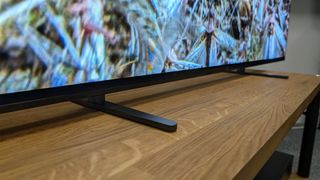
Out of the box, the Sony Bravia 8 looks a lot like its predecessor, the A80L. Standing one next to the other in our viewing rooms there are a few subtle differences, however.
At a superficial level, the rear, while still made of plastic, has a slightly different square textured pattern running along it. It’s also noticeably flatter than the A80L’s, which helps it sit flush on a wall when mounted.
But more important tweaks have been made to its stand and remote. The Bravia 8’s foot stands have been tweaked to have a flat top and be slightly thinner. The A80L’s look slightly chunky by comparison. This is an intentional tweak by Sony designed to make it easier to plonk a soundbar across the feet.
For those planning to use it on a larger stand, the TV retains two position options for the feet. One that places them close together in the middle of the Bravia 8’s bottom edge, and a second where they sit on the right and left corners – the latter allowing for a larger soundbar to sit underneath the TV without touching the foot stands.
On the off-chance you don’t want a soundbar, the feet can also be set to two heights, one placing the set incredibly close to your table stand, another raising it 10cm higher.
The configuration works well and means the TV can neatly sit on most standard-sized TV stands. The only slight issue is that, unlike many pedestal stands, there’s no pivot/swivel mechanism. This isn’t a deal breaker but we’re always fans of a hinge mechanism on a stand as it not only lets you quickly adjust the screen’s orientation on the fly, it also makes it easier to access the set’s HDMI inputs.
Our only other minor quibble is that Sony has made the Bravia 8’s remote a purely plastic, slightly cheap-feeling affair. Unlike with the A80L or Bravia 9, the remote’s top doesn’t have a metallic finish and it feels significantly cheaper as a result.
This is semi-forgivable as it is otherwise well stacked, featuring useful shortcut buttons to commonly used streaming services, plus a backlight – a key item missing on the remote of its arch-rival, the LG C4.
Features
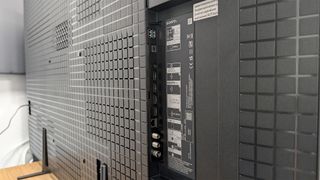
Despite having very few aesthetic changes to the Bravia 8, Sony’s made some important upgrades under the hood.
The headline stat is that the Bravia 8’s WOLED panel is quoted as being 10 per cent brighter than its predecessor. This makes it the latest in a long line of step-down OLED TVs to market higher maximum brightness as a key reason to upgrade this year.
LG made the same claim with the LG C4, and Philips followed suit with its OLED809, which passed through our viewing rooms just before the Bravia 8’s arrival.
However, while this means the Bravia 8 still won’t go as bright as its QD-OLED sibling, the Sony A95L or the MLA-equipped LG G4 – which can go up to 3000 nits’ peak brightness – this is still a bold claim by Sony. The A80L remains one of the brightest standard OLED TVs without MLA or QD-OLED, despite being over a year old.
The TV is powered by the same Bravia XR processor as the more expensive Bravia 9. The XR processor, like all the new TV chips we’ve seen this year, promises to leverage AI to improve the set’s picture processing and let it deliver an even more authentic, natural-looking home cinema experience – an achievement it largely manages, based on our testing, at least on the Bravia 8.
The AI-focused chip aims to do a similar thing with audio, using its processing chops paired with Sony’s unique Acoustic Surface Audio+ hardware in an attempt to offer radically better virtual surround sound.
The Acoustic Surface Audio+ tech has been a staple feature on Sony TVs for quite some time. It uses under-screen actuators to produce sound rather than traditional speakers. The idea here is to ensure the sound comes from the same place as the image, helping it lock on better.
The set-up on the Bravia 8 is identical to the A80L’s. Specifically, it’s a 50W system consisting of three actuators and two bass drivers. Dolby Atmos and DTS:X support also make a return and round out the TV’s audio features.
Outside of this, the Bravia 8’s features remain largely unchanged from its predecessor. The set runs using the Google TV operating system, which is more than good enough for most people. All the heavy-hitting apps are supported including Netflix, Disney Plus, Apple TV+ and Amazon Prime Video.
Specialist Sony-owned apps including Sony Pictures Core and Crunchyroll (the best anime streaming service available in our opinion) are also present. In the UK, local streaming app support is also solid with BBC iPlayer, ITV X, Channel 4 and Channel 5 all included – many Google TVs are missing these. Having tried them all we can also confirm that all correctly stream in 4K / HDR where applicable.
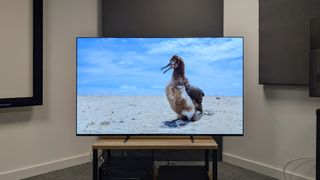
Screen size 65-inches (also available in 55- and 77-inches)
Type OLED
Backlight NA
Resolution 4K
HDR formats HDR10, HLG and Dolby Vision
Operating system Google TV
HDMI Inputs 4 x (2 x 48Gbps HDMI 2.1)
Gaming features 4K/120Hz, VRR, ALLM
ARC/eARC eARC
Optical output? Yes
Dimensions (hwd, without stand) 83 x 144 x 3.7 cm
In the same vein, all the usual formats are supported, the Bravia 8 working with HDR10, Dolby Vision and HLG. Like the Bravia 9 there’s also an IMAX Enhanced picture mode. The only ongoing omission is HDR10+. Normally, we’d be forgiving of this as Prime Video is the only mainstream service pushing the standard. But the presence of a new Prime Video Calibrated mode makes it feel slightly odd on the Bravia 8.
The new mode works in a similar way to the TV’s Netflix Calibrated Mode and Sony Pictures Core Calibrated Mode (previously known as Bravia Core Calibrated Mode). It aims to optimise the TV’s settings based on the type of content being played within the app. Taking it for a quick spin switching between sports and films, these 'optimisations' equate to minor picture adjustments to colours and brightness, rather than massive shifts.
For gamers, the Bravia 8 is in many ways excellent, but it again comes with a few omissions common to most of the non-LG or Samsung OLED TVs we test. The first is that only two of the set's four HDMI sockets meet the 2.1 standard, and one of those doubles as an eARC connection.
This is fine if you just want to connect one current generation games console and a Dolby Atmos soundbar. Current games consoles require an HDMI 2.1 input to run at full speed. To get Dolby Atmos you need to connect a compatible bar to the eARC input. So if you have a PS5 and Xbox Series X/S and Atmos soundbar, you will have to contend with a fair amount of cable swapping or make do with one of your consoles being more limited than it should be.
The inputs also only run at 120Hz in 4K, rather than the super-fast 144Hz seen on the rival LG C4. Though, as current consoles can only go up to 120Hz, this will only be an annoyance for PC gamers with supremely powerful rigs. Outside of this both the HDMI 2.1 inputs support VRR and ALLM – two key features that help make games feel more fluid and reactive.
Finally, Dolby Vision Gaming is present, which is another minor upgrade for the Bravia 9 on the A80L and a welcome addition for Xbox gamers, as the latest X/S consoles support the standard. This is a version of Dolby’s film and TV HDR standard optimised for games. It brings the same benefits, including better contrast and more accurate colours on compatible games mastered to the standard – of which there are roughly 100 available on Xbox.
Picture
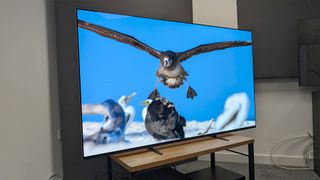
If you think the technical upgrades detailed above sound small then you’d be right. But as we saw earlier this year reviewing the LG C4, specifications never tell the full story, and sometimes seemingly modest updates yield big improvements in the real world.
Is this the case with the Bravia 8? To find out, we put the Bravia 8 through its paces, comparing it directly with its predecessor, the A80L, in our viewing rooms. In this set-up we used an HDMI splitter so that both TVs were getting an identical signal and the Oppo UDP203 Blu-Ray player as the source, unless otherwise specified. The Blu-ray player and splitter were set up to send content to the TVs in its native format, so any upscaling or processing would be done by the TVs.
To start, there is some fandangling to be done to get the most out of the Bravia 8. Out of the box, playing a heated desert battle scene from our Dune Part 2 test disc, both TVs’ Standard mode is a little too heavy-handed for our liking, adding an artificiality to the picture and characters’ movements.
The Cinema mode acts as a middle ground for people who want 'pop' and a 'blow your socks off' experience that still retains some semblance of realism. But for purists who value an 'as the director intended' experience, there’s still a little too much going on. For example, the peak bright parts of the picture, including the desert sun, occasionally go too bright compared with the rest of the scene and lose detail, distracting us from the characters.
We get the best results moving to the Bravia 8’s 'Professional' mode. This is Sony’s equivalent to a Filmmaker mode, in that it aims to reduce processing to its absolute minimum and offer a picture that is as the director intended. Running the same Dune Part 2 test scene, our previous issues are largely fixed. Lost details and a wider, more natural-looking hue return to the desertscape and skin tones.
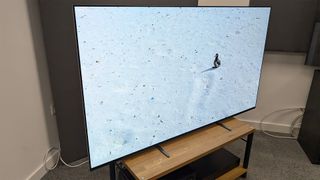
However, while the very minor but slightly distracting spikes in brightness disappear, some dynamism is lost. Rapid movements of a missile blasting towards an enemy flying machine have a very slight stutter. To get a happy medium and the best results we raise the Peak Luminance setting to Medium and motion processing to its lowest setting.
Once in these settings, the TV performs very well. The first and most immediate is how it handles colours, particularly skin tones. The Bravia 8’s picture is wonderfully natural, with characters' skin tones offering more reds than the A80L, which shifts more to the blue end of the spectrum. The same is true of the rebels’ desert suits, which have a browner, more realistic tone.
The trend continues with the opening scene of Blade Runner 2049. Watching Ryan Gosling’s character fly into a dusty protein farm, motion handling is beautiful and we don’t see any artefacts as his car zooms over the landscape and a recon drone examines the scene. Dark areas retain oodles of detail, with every crinkle in the sofa in Dave Bautista's home being apparent. The Bravia 8 offers warmer skin tones with Bautista's hulking character’s face having noticeably more life than the cooler A80L, creating, once again, a more natural picture.
To our surprise the Bravia 8’s light control has been refined, giving the picture even more depth and a wonderful three-dimensionality. Light leaking into the dark room reflecting off a kitchen counter oozes detail, showing the surface’s texture and offering a true sense of depth.
Moving to Oppenheimer, the Bravia 8 continues to impress. Black and white scenes reveal exceptional levels of detail, with every stitch and weave on characters’ suits and ties remaining clearly visible. The picture is wonderfully sharp and doesn’t appear flattened, as it does on the flagship Bravia 9, with characters and objects holding a true sense of depth and separation from the scene’s background.
But what about Sony’s 10 per cent higher peak brightness claims? Flipping things around with Pan, a terrible movie we often use to test peak brightness due to its atypical 4000 nits mastering, the Bravia 8 continues to impress. As the pirates’ flying ship sails through the sky, the Bravia 8 delivers immersive peak brights that retain a smidgen more detail than the A80L. The setting sun offers a slightly wider hue and tiny details around the clouds that are lost and displayed as pure white on the A80L.
It is the same story running Rogue One on Disney Plus, which we use to test Dolby Vision HDR performance. Dolby Vision Dark Mode makes the picture look a little dull, with the halo around planets and stars looking less impressive than we’d expect. Switching to Dolby Vision Bright mode, the Bravia 8 comes to life, offering significantly more punch, with distant stars twinkling and reflections in the sea glistening without the TV losing its sense of realism and authenticity.
So, all-in-all, the Bravia 8 is a fantastic TV that delivers great picture quality. But there are two small flies in the ointment.
The first relates to its handling of SDR, Full HD content, where the Bravia is good, but not best in class. Here we start by using our standard True Grit Blu-Ray test disc. This is a great movie for testing due to its grainy, dusty quality which properly stretches any TV’s upscaling powers. The film retains its natural grain, and appears wonderfully sharp – textures on the characters’ thickly spun cotton clothes ooze detail and skin tones look nicely sun-scorched. But some black crush does occur in particularly dark scenes.
There’s also the fact that, while the Bravia 8 is a great TV, the differences between it and the A80L are modest – we’re talking single-figure percentage improvements at best. This is particularly noticeable this year, where the difference between Sony’s OLED offering and key rivals has grown smaller.
The Philips OLED809 matches, and at times beats, the Bravia for blow-your-socks-off “this is bright” sections of the picture, and the LG C4 has come on leaps and bounds in this area too – we’re yet to get Panasonic’s range of Z-series OLEDs or the rival Samsung S90D in for review, which is why they’re not mentioned here.
This doesn’t make the Bravia 8 bad – remember the A80L is still excellent, so any improvements on its performance are still impressive.
Sound
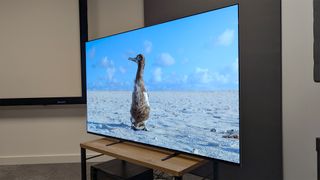
The Bravia 8 is one of the better-sounding OLED TVs we’ve tested, but again not a huge step forward for Sony.
Like all the brand’s flagships it uses Sony’s unique Acoustic Surface Audio+ technology, which involves actuators that vibrate the whole screen to generate sound.
Running our standard chapter two of Blade Runner 2049 stress test, the TV’s audio is slightly bass-light, even compared to rival sets. But it makes up for this with its control. The thumping, deep drum part doesn’t have the impact needed to get your heart truly beating, and the roaring synth underscoring it doesn’t dig deep enough to pull you into the scene the way even a moderately capable soundbar can.
But we don’t experience any distortion or loss of precision as we do on most TV speaker systems – at least until we raise the volume above 80 per cent. Once again, Sony has sacrificed direct impact for control with the Bravia 8’s sound.
The Cinema sound mode offers a nicely spacious, controlled experience. Watching Ryan Gosling’s Blade Runner 2049 character converse with a hologram moving around an apartment, the voices are suitably differentiated from background noise and the scene’s soundtrack. There’s also a sense of direction, with the hologram’s disembodied voice projecting and matching its movements on screen better than expected.
This is equally true when we switch to a car chase scene in The Batman. The Batmobile’s engines may not growl the way we want, but the sound follows the car’s movements with suitable accuracy to immerse us in the scene and make us feel like we’re in the midst of a fast-paced chase. There aren’t many TV in-built speaker systems around that can achieve the same results.
For us, this control and spaciousness are worth sacrificing some low-end heft for. Though, again, we’d still recommend investing in a soundbar or speaker package if you want the best experience possible.
Verdict
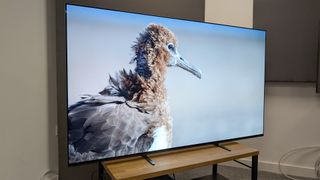
The Bravia 8 is not a massive step forward for Sony OLED TVs. It doesn’t have QD-OLED and it isn’t a night and day improvement on its predecessor the way the LG C4 is compared with the LG C3. But, you have to remember the A80L was a What Hi-Fi? Product of the Year award winner when it came out and to this day remains a stellar OLED TV.
This means that the very fact Sony has managed to improve it at all is impressive, especially as the upgrades target the key areas cinephiles care about. Skin tones are warmer and more realistic, and advances in its light control make the picture look wonderfully three-dimensional. Audio also remains a cut above the experience you’ll get on rival sets. So while the Bravia 8 may be a hard sell for people who only recently bought an OLED TV in the past few years, it is still an incredible set worth considering for everyone else.
First reviewed: September 2024. Updated review: November 2024.
SCORES
- Picture 5
- Sound 5
- Features 4
MORE:
Read our review of the LG C4
Also consider the Philips 809
Read our Sony A80L review
Best OLED TVs: the latest and greatest models, tested by our experts
